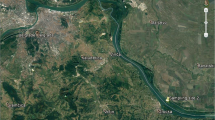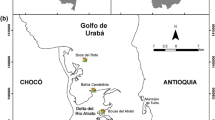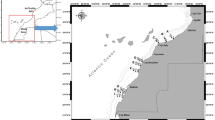Abstract
Heavy metal accumulation of lead (Pb), chromium (Cr), and cadmium (Cd) in the muscle of the catfish Eremophilus mutisii was studied in 47 specimens, captured by anglers in the Bogotá River at two sampling sites (Chocontá and Suesca) during May–October 2005. Water samples were processed for physicochemical and metal analyses. Metal accumulation in muscle (wet weight) of specimens at Chocontá and Suesca showed high levels of Pb (3.4 and 3.1 ppm, respectively), Cr (1.8 and 2.1 ppm, respectively), and Cd (0.35 and 0.48, respectively). Metal levels in waters (ppm) indicated that average Pb (0.028 Chocontá, 0.029 Suesca), Fe (0.462 Chocontá, 1.1 Suesca), and Cr (0.113 Chocontá) were above the maximum levels (MCLs) allowed in drinking waters. No extreme average values were found for pH, nitrites, alkalinity, and hardness in the waters. This study showed the importance of benthic and nonmigratory species like the capitán to evaluate the effects of heavy metals pollution. Further public health implications could be derived in the region where this investigation took place due to consumption of capitán by people in the area.


Similar content being viewed by others
References
Alquezar R, Booth S, Booth D (2005) Metal accumulation in the smooth toadfish, Tetractenos glaber, in estuaries around Sydney, Australia. Environ Pollut 20:1–9
APHA (American Public Health Association) (1992) American Water Works Association and Water Pollution Control Federation. Standard methods for the examination of water and wastewater, 17th edn. American Public Health Association, Washington, DC
Bervotes L, Blust R, Verheyen R (2001) Accumulation of metals in the tissues of three spined stickelback (Gasterosteus aculeatus) from natural fresh waters. Ecotoxicol Environ Safety 48:117–127. doi:10.1006/eesa.2000.2010
CAR (Corporación Autónoma Regional de Cundinamarca) (1985) Contaminación ambiental producida por la industria del curtido. Corporación Autónoma Regional de Cundinamarca, Bogotá
CAR (Corporación Autónoma Regional de Cundinamarca) (1998) Cuenca Alta del Río Bogotá. Descripción y diagnóstico. Corporación Autónoma Regional de Cundinamarca, Bogotá
Carvalho CS, Fernández MN (2006) Effect of temperature on copper toxicity and hematological responses in the neotropical fish Prochilodus scrofa at low and high pH. Aquaculture 251:109–117. doi:10.1016/j.aquaculture.2005.05.018
Colt JE, Tomasso JR (2001) Hatchery water supply and treatment. In: Wedemeyer G (ed) Fish hatchery management, 2nd edn. American Fisheries Society, Bethesda, pp 91–186
Dallas HF, Day JA (1993) The effect of water quality variables on riverine ecosystems: a review. WRC project No. 351. Water Research Commission, Pretoria South Africa
Demirak TA, Yilmaz F, Tuna AL, Ozdemir N (2005) Heavy metals in water, sediment and tissues of Leuciscus cephalus from a stream in southwestern. Chemosphere 30:1–8
DVGW (Deutscher Verein des Gas- und Wasserfaches E.V.) (1985/1988) Daten und Informationen zu Wasserinhaltsstoffen (Data about water composition), Part 1: 1985; Part 2: 1988. Eschborn
Eisler R (1986) Chromium hazards to fish, wildlife, and invertebrates: a synoptic review. Biological Report 85(1.6) Contaminant Hazard Reviews. Report No. 6. Patuxent Wildlife Research Center. US Fish and Wildlife Service, Laurel, MD, 38 pp
EEC (European Economic Community) (2001) Regolamento No. 466/2001 della Commissione dell` 8 marzo 2001 che definisce i tenori massimi di taluni contaminanti presenti nelle derrate alimentary. Gazzetta Ufficiale delle Comunitá Europee, L77 (16 March)
EPA (Environmental Protection Agency) (2004) Drinking water standards and health advisories. EPA 822-R-04-005. Office of Water, Washington, DC
Forstner U, Wittmann GTW (1983) Metal pollution in the aquatic environment, 2nd edn. Springer, Berlin
Hogendoorn-Roozemond AS, Ten Holder VJHM, Strik JJTWA, Kolar Z, Koeman JH (1978) The influence of pH on the toxicity of hexavalent chromium to rainbow trout (Salmo gairdnerii). In: Hutzinger O, van Lelyveld IH, Zoeteman BCJ (eds) Aquatic pollutants. Transformation and biological effects. Pergamon Press, Oxford, pp 477–478
Mayorga M (1992) Biología reproductiva y alimenticia del capitán de la sabana (Eremophilus mutisii) en la laguna de Fúquene. Undergraduate research thesis, Universidad de Bogotá, Jorge Tadeo Lozano, Marine Biology, Bogotá
Mojica JI, Castellanos C, Usma JS, Álvarez R (eds) (2002) Libro Rojo de Peces dulceacuícolas de Colombia. La serie Libros Rojos de Especies Amenazadas de Colombia. Instituto de Ciencias Naturales Universidad Nacional de Colombia, Ministerio del Medio Ambiente, Bogotá
Naddy RB, Stubblefield WA, May JR, Tucker SA, Hockett R (2002) The effect of calcium and magnesium ratios on the toxicity of copper to five aquatic species in freshwater. Environmen Toxicol Chem 21:347–352. doi:10.1897/1551-5028(2002)021<0347:TEOCAM>2.0.CO;2
Newman MC (1995) Quantitative methods in aquatic ecotoxicology. CRC/Lewis Publishers, Boca Raton
Noga EJ (1996) Fish disease: diagnosis and treatment. Iowa State University Press, Ames, p. 367
Ojeda D (2004) Diagnóstico ambiental por vertimiento de residuos de curtiembres al río Bogotá en el corredor industrial de Villapinzón-Chocontá cuenca alta del río Bogotá. Undergraduate research thesis, Universidad Nacional de Colombia, Bogotá
Payne JF, French B, Hamoutene D et al (2001) Are metal mining effluent regulations adequate identification of a novel bleached fish syndrome in association with iron-ore mining effluents in Labrador, Newfouland. Aquatic Toxicol 52:311–317. doi:10.1016/S0166-445X(00)00166-1
Ramos JP, Camacho LA (2004) XXI Congreso Latinoamericano de Hidráulica São Pedro. IAHR-AIPH. Estado de São Paulo, Brasil
Rayms-Keller A, Olson KE, McGaw M, Oray C, Carlson JO, Beaty BJ (1998) Effect of heavy metals on Aedes aegypti (Diptera:Culicidea) Larvae. Ecotoxicol Environ Safety 39:41–47. doi:10.1006/eesa.1997.1605
Robinson J, Avenant-Oldewage A (1997) Chromium, copper, iron and manganese bioaccumulation in some organs and tissues of Oreochromis mossambicus from the lower Olifants River, inside the Kruger National Park. Water SA 23:387–403
Tarifeno-Silva E, Kawasaki L, Gorden MS, Chapman DJ (1982) Aquacultural approaches to recycling dissolved nutrients in secondarily treated domestic waste waters: uptake of dissolved heavy metals by artificial food chains. Water Res 16:59–65. doi:10.1016/0043-1354(82)90053-7
Vargas G, Pinilla GA (1991) Pesca artesanal en la laguna de Fúquene: características e importancia económica. Reporte Técnico. Universidad de Bogotá Jorge Tadeo Lozano, Bogotá, Colombia
Acknowledgments
The authors thank Fundación Al Verde Vivo, EMGESA, and MERCK (Germany) for their financial and logistic support.
Author information
Authors and Affiliations
Corresponding author
Rights and permissions
About this article
Cite this article
Rodríguez Forero, A., González Mantilla, J.F. & Suárez Martínez, R. Accumulation of Lead, Chromium, and Cadmium in Muscle of capitán (Eremophilus mutisii), a Catfish from the Bogota River Basin. Arch Environ Contam Toxicol 57, 359–365 (2009). https://doi.org/10.1007/s00244-008-9279-2
Received:
Accepted:
Published:
Issue Date:
DOI: https://doi.org/10.1007/s00244-008-9279-2




